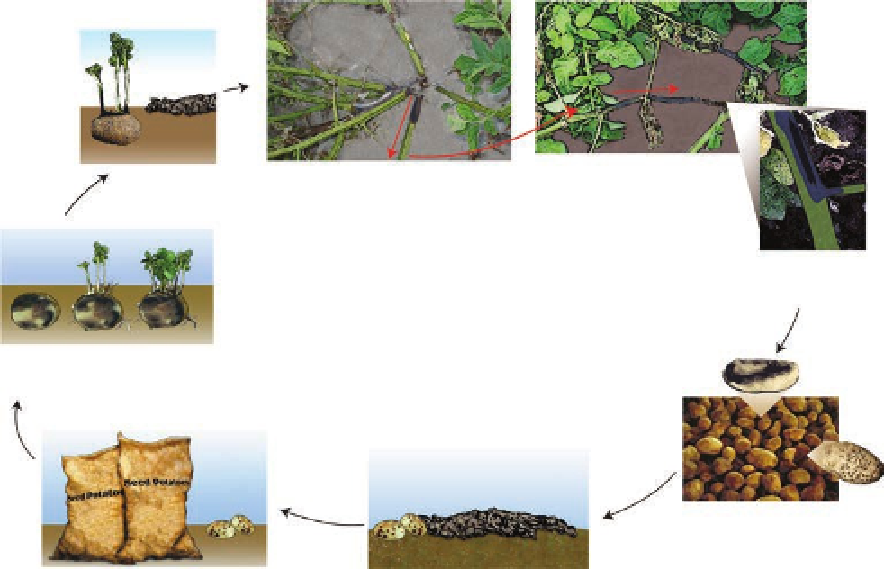Agriculture Reference
In-Depth Information
SUMMER
Bacteria spread from infected tubers up the stem, causing blackleg.
Infection is transferred from infected plants through splash dispersion from rain and
irrigation, as well as through feeding insects, resulting in aerial stem rot.
Saturated soil can cause tuber
lenticels to open, which can
result in infection.
EARLY
SPRING
Infection spreads from leaves down
to tubers and leaf debris on soil
surface. Anerobic soil conditions
exacerbate soft rot.
Bacterial soft rot
disease cycle
FALL
Seed pieces are cut, creating an open wound
for the pathogen to enter. Infection spreads
from the seed piece to sprouts, resulting in
blackleg.
During storage, rotting tubers release liquid
containing the bacteria, initiating rotting of
surrounding tubers.
Infected seed and volunteer potatoes are sources of
new inoculum for the next growing season.
The pathogen survives on plant debris
and on latently infected tubers.
WINTER
Fig. 11.4.
The disease cycle of soft rot bacteria (
Pectobacterium
spp.).
through the plant's vascular tissue, are more ag-
gressive, and have higher optimal temperatures
for disease development.
Dickeya
spp. also appear
to be less robust than
Pectobacterium
spp. in soil
and other environments. Like
Pectobacterium
spp., the principal control for
Dickeya
spp. in-
volves seed tuber certification and consequent
rejection of infected seed lots. If, however, seed
lots are contaminated uniformly, as reported for
Pectobacterium
spp. (Perombelon, 1992), im-
proved diagnostic techniques would have to be
interpreted carefully to determine critical inocu-
lum loads.
The pathogens that cause soft rot of tubers,
wilting, and stem and foliar necrosis may be
introduced as secondary infecting pathogens
after the plant has been compromised. For ex-
ample, bacterial soft rots of tubers can be intro-
duced after fungal infection, or through wounds
caused by mechanical damage
(Fig. 11.4
)
. Prac-
tices that reduce exposure to damage during
harvest, storage, and post-storage are important
in the control of soft rots. These were reviewed
by Knowles and Plissey (2007) and included a
checklist of preharvest factors such as washing
digging equipment, timing of crop desiccation
(dependent on canopy and tuber maturity), stor-
age preparation including inspection, repair,
and cleaning of insulation, ducts, fans and hu-
midifiers, doors, and sensors and control panels.
Modifications to harvest equipment are import-
ant factors in managing soft rot bacteria and
other pathogens that enter through damaged
tuber periderm. Knowles and Plissey (2007)
identified the harvester as being the major
source of mechanical damage to tubers and
made recommendations that could reduce dam-
age. These included adjustments to the digging
blade, reducing drop heights, use of oblique flow
angles, and use of rubberized soft surfaces to de-
crease bruising. The potential for damage con-
tinues from harvest to the loading of tubers on
to bulk trucks and to the storage-bin piler, and
similar recommendations based on the use of
improved padding and flow speeds have been
made. Preferably, crops should be harvested

